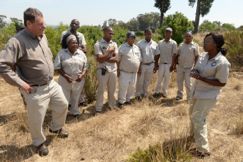Dump site transformed into Cape nature reserve
5 January 2015
A 36-hectare area in Cape Town that was once used largely as a landfill has been
transformed into one of the city's most important nature reserves, home to more than
300 plant species, 10 of which are endemic to Cape Town and threatened with
extinction.
After a decade of hard work – and a R2-million investment – the once deteriorated and
deserted Bracken Nature Reserve has been rehabilitated and restored into a
environmental space that can be enjoyed by all the city's residents, the City of Cape
Town said in a statement last week.
Bracken Nature Reserve was named as the reserve of 2014 by the city's Environmental
Resource Management Department.
The rehabilitation project started with the planting of 60 indigenous trees including,
karee, real yellowwood, wild peach, Cape ash, wild camphor and milkwood, which are
still growing well.
Councillor Johan van der Merwe, the City's Mayoral Committee Member for
Energy,
Environmental and Spatial Planning, singled out Tshepo Mamabalo for her will and vision
in transforming the space.
Mamabolo's involvement began when she was doing a city internship at the reserve.
"With the support of the reserve team, she dedicated her passion and energy to
transforming the site into what it is today," Van der Merwe said.
Mamabolo is now the area co-ordinator.
Conservation
The 36-hectare reserve is home to Swartland granite renosterveld and Cape sand
fynbos, both of which "suffer a dearth of conservation consideration", the city said.
"More than 300 plant species have been identified here, of which 10 are endemic to
Cape Town and threatened with extinction," the city said.
Important species include cowslip (Lachenalia aloides) and the canary yellow vygie
(Lampranthus glaucus).
The reserve also supports a great diversity of wildlife. Regularly sighted birds are the
red-capped lark,
black-shouldered kite, peregrine falcon and southern double-collared
sunbird. Other mammal species found in the reserve include the small grey mongoose
and a myriad of rodents and reptiles.
Critically endagered
"Currently there is only one known plant of the critically endangered Kraaifontein
spiderhead (Serruria furcellata) remaining naturally in the wild in Northpine," Van der
Merwe said.
"The reserve has been surveyed and found to have great potential as a receptor site for
this critically endangered species. Cuttings from the original plant were planted and, to
date, 20 healthy plants are conserved at the reserve."
The City manages 16 nature reserves across Cape Town. During the 2013/2014 financial
year, visitor numbers to City reserves increased by 32% to 351 594 visitors
(2012/2013: 266 195 visitors).
"The tremendous turnaround of the Bracken Nature Reserve is a good example of how,
when the city sows the seeds of
collaborative partnerships, the community and the
surrounding environment will reap the benefits," Van Der Merwe said.
"It is of paramount importance that we place a higher financial and environmental value
on our nature reserves so that, together, we can make progress possible in building a
sustainable future," he said.
Bracken Nature Reserve details
- Address: 2 Reservoir Road, Brackenfell Map directions
- Opening hours: 07:30-16:00 (daily)
- Size: 36 hectares
- Entrance fee: None
- Public transport: Taxi
- Activities: Picnic areas, walking trails, birdwatching, wheelchair-friendly trail. Please
note: This reserve has a "no-bin policy" and all visitors must take their rubbish home
with them.
- Environmental
education: Brackenfell Environmental Education Centre (booking
essential)
- Contact: Tel +27 21 444 0380
- The Friends of Bracken and CREW (Custodians of Rare and Endangered Wild
Flowers) arrange walks, birdwatching, plant surveys and alien clearing. www.brackenfell.org/
SAinfo reporter
 Area coordinator Tshepo Mamabolo (right) and the Bracken Nature Reserve team talk to Councillor Johan van der Merwe, Cape Town's mayoral committee member for energy, environmental and spatial planning (left) about the critically endangered Serruria furcellata plants (Image: City of Cape Town)
Area coordinator Tshepo Mamabolo (right) and the Bracken Nature Reserve team talk to Councillor Johan van der Merwe, Cape Town's mayoral committee member for energy, environmental and spatial planning (left) about the critically endangered Serruria furcellata plants (Image: City of Cape Town)


